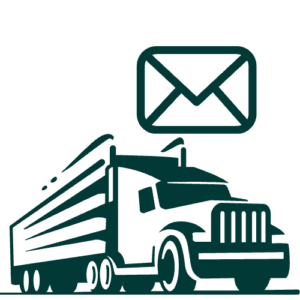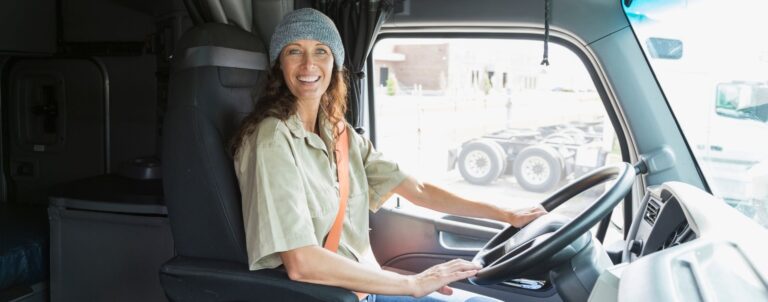Driving a commercial vehicle, especially something as big as a semi-truck, is a big responsibility. That’s why the government requires most people driving vehicles for a living to have a special license.
It’s usually the first thing someone gets when getting into the trucking industry. There are a lot of things to consider before investing the time and money it takes.
Here’s everything you need to know about getting your CDL.
Leer este artículo en español.
Subscribe to our YouTube channel for more videos!
What is a CDL?
CDL stands for commercial driver’s license – they are issued by state governments and the baseline requirements are established by the Federal Motor Carrier Safety Administration (FMCSA). It’s required by law for most people operating commercial vehicles because doing so requires more skills and knowledge than driving a regular car.
Do I need a CDL to drive trucks professionally?
At the federal level, the FMCSA is very clear about the types of vehicles that require a CDL to operate. For the trucking industry, requirements are mainly based on weight. Here are the different classes of CDLs, straight from the FMCSA website, and the types of vehicles you can operate with those licenses:
| Class | Official description from the FMCSA | Types of vehicles included |
| Class A | Any combination of vehicles that has a gross combination weight rating or gross combination weight of 11,794 kilograms or more (26,001 pounds or more) whichever is greater, inclusive of a towed unit(s) with a gross vehicle weight rating or gross vehicle weight of more than 4,536 kilograms (10,000 pounds) whichever is greater. | – Tractor-trailers: AKA semi-trucks, big rigs or 18-wheelers – Truck and trailer combinations – Tanker vehicles – Livestock carriers – Flatbeds – Most Class B and Class C vehicles, depending on endorsement requirements |
| Class B | Any single vehicle which has a gross vehicle weight rating or gross vehicle weight of 11,794 or more kilograms (26,001 pounds or more), or any such vehicle towing a vehicle with a gross vehicle weight rating or gross vehicle weight that does not exceed 4,536 kilograms (10,000 pounds). | – Straight trucks: vehicles with fixed trailers, generally smaller than a semi-truck. – Large buses: city buses, tourist buses, and school buses – Segmented buses, – Box trucks: delivery trucks and furniture trucks – Dump trucks with small trailers – Some Class C vehicles with the correct endorsements. |
| Class C | Any single vehicle, or combination of vehicles, that does not meet the definition of Class A or Class B but is either designed to transport 16 or more passengers, including the driver or is transporting material that has been designated as hazardous under 49 U.S.C. 5103 and is required to be placarded under subpart F of 49 CFR Part 172 or is transporting any quantity of a material listed as a select agent or toxin in 42 CFR Part 73. | – Double/Triple Trailers: a standard tractor trailer with additional trailers attached to it – Buses – Tank Trucks: AKA tanker trucks designed to carry liquids or gases – HazMat Vehicles: used to transport hazardous materials |
If you’re uncertain of the type of vehicle you’re going to operate, we suggest getting a Class A CDL. This allows you the most flexibility and opportunity as a driver. A CDL is not required for vehicles weighing less than 26,000 lb and transporting less than 16 passengers. Some box trucks, cargo vans, and hotshot vehicles can be operated without having a CDL.
However, depending on your state of residence and the vehicle(s) you plan to operate, you may or may not need to get a CDL. Make sure you check with your state’s regulations first to understand if there are any additional requirements.
What special endorsements do I need?
In addition to choosing a class of CDL, you’ll also want to review the different types of endorsements available. These endorsements require separate exams and allow you to haul specific kinds of trailers and freight:
- Hazardous material (H)
- Tank vehicles (N)
- Double or Triple trailers (T)
- Tank vehicle and hazardous materials (X)
If you’re not sure whether or not you’ll need a special endorsement or what kind of freight you’ll haul, start by getting your Class A CDL and then prepare for endorsements as needed.
Am I eligible to get a CDL?
While every state has its own additional requirements for obtaining a CDL, there are some basic requirements needed to be eligible across all states:
- Have an existing non-commercial driver’s license
- Be 18 or older
- One to two years of experience driving with a non-commercial license
- A clean driving record
- Be able to pass a background check
- English comprehension
- A medical examiner’s certificate for vision and health conditions.
- Depending on your state, you may also need a social security number.
Contrary to popular belief, you do not need to be a US citizen to get a commercial driver’s license. If you have a green card, meaning you are considered a “lawful permanent resident” or LPR, you have access to a social security number and are eligible to apply for any type of driver’s license.
If you’re not a permanent US resident, you may still be eligible. If you’re a resident of Canada or Mexico, you should obtain a commercial driver’s license there – the USDOT recognizes Canadian and Mexican CDLs as valid. In fact, you’re not legally allowed to have more than one valid CDL, so if you already have one from Canada or Mexico, you can simply continue to use it, even if you work in the US.
If you are not a permanent resident of the US, Mexico, or Canada, you may still be able to get a CDL. This process is called a “non-domiciled CDL”. According to federal law, you’ll need to present an unexpired employment authorization document (EAD) from the US Customs and Immigration Service (USCIS) and an unexpired foreign passport and approved I-94 form documenting your last entry into the US. However, depending on the state where your CDL is issued, they may have additional requirements. Here’s a directory of all 50 states’ driver’s license issuing agencies.
If you do not yet have authorization to work in the US, we highly recommend speaking with an immigration attorney as this will be an obstacle to being able to work in any industry.
How can I get my CDL?
As we’ve mentioned above, CDLs are issued by state governments, so the process for obtaining a CDL varies depending on each state’s regulations. However, there are some universal steps:
Understand your state’s requirements and process
Things like license type, age restrictions, and timelines vary from state to state. Before investing any money in a CDL school or studying for your CLP exam, make sure you are eligible and understand how to get a CDL in the state where you live and work.
Complete a driver training program
If you want to get a Class A or Class B CDL, you’ll need to take a driving training class offered by an FMCSA-approved training center. A directory of these providers is available on the FMCSA website.
Important note: you’ll likely do a drug screening as part of this training program. Remember, even if recreational marijuana is legal in your state, it’s still illegal on the federal level, so you cannot test positive for marijuana in any screening during any of the processes to get your CDL or while working as a driver or owner-operator.
Complete a physical
You’ll also need to submit the results of a physical via a Medical Examination Report Form and Medical Examiner’s Certificate.
If you are going to drive across state lines, you must complete your physical with an FMCSA-certified medical examiner (CME). If you’re only going to be driving intrastate routes, you can get your physical done with a state-approved provider.
You’ll need to renew this physical at least every 24 months to avoid your CDL from downgrading.
Obtain a commercial learner’s permit (CLP)
This is a similar concept to the learner’s permit you may have gotten before your regular driver’s license. Getting a CLP requires passing a number of written exams, depending on your state. For study guides and practice tests, see Driving Tests, Test Guide, and Become.
Many companies will help you get your CDL, but you may need to get or be in the process of getting your CLP before they’ll hire you.
Schedule and practice for your state’s CDL driving skills test
You’ll need to wait at least 2 weeks from the time your permit was issued to schedule your CDL road skills test. Be aware that even if you are practicing on a vehicle with an automatic transmission, you may be required to perform your driving test using a manual transmission.
Pass a pre-trip inspection and road skills test
The pre-trip inspection part of the driving test can be nerve-wracking. It’s a verbal exam that will require you to walk around the vehicle and check every part for damage or other safety concerns. You won’t have access to any paperwork or cheat sheets, so studying for this portion of the exam is very important.
There are an endless number of videos on the pre-trip inspection and road skills test. If you’re in a training program, however, they should provide you with all the necessary information and materials for studying.
Pay the fees for your CDL
After all the tests on paper and on the road, you will need to pay a fee for getting your official CDL if it’s not included in your driver training program or provided by your company. These fees are generally very nominal but vary by state.
How much does it cost to get a CDL?
The bulk of the cost associated with getting a CDL is paying for the driver training program. These programs can cost thousands of dollars. If you’re short on cash to pay for the program, there are companies that will actually pay for you to get your CDL if you agree to work for them afterward for a certain length of time.
Some companies’ programs will even pay you to learn how to drive! But be careful. There are programs that take the cost of training out of your paycheck. Still, others may require you to pay for your training up-front and then reimburse you over a period of time.
Company-sponsored programs can be a great, cost-effective way to get your CDL. However, most companies that pay for your training will offer relatively low wages in the first year, so if you have the cash to pay for your own training upfront, it might be worth it. Like anything, it depends on your circumstances! Take in as much information as you can and make the best decision for you.
Another option is to apply for a grant or scholarship. Pell grants are a great option for those with limited financial resources and who don’t have a bachelor’s degree.
If you’ve served in the military, you may be eligible for financial aid from the driving schools themselves. And if you’ve already operated a commercial vehicle while serving, you may be able to take advantage of the FMCSA’s Military Skills Test Waiver.
Programs created under the Workforce Innovation and Opportunity Act and Workforce Investment Act offer financial assistance to those looking to change careers.
Finally, scholarships are also available. The Women in Trucking Foundation, for example, awards scholarships to women looking to get into the industry. Other funds award scholarships to veterans and first responders. In short, there are a ton of financing opportunities available, but the research and application process will take some time and dedication.
We covered more details in our article How Much Does A CDL Cost? An FAQ For Aspiring Truck Drivers. Read more >>
How long does it take to get a CDL?
Getting your CDL can take as little as three weeks, but this will depend on the state where you live, whether you’re doing a part-time or full-time training program, and the CDL class and endorsements you’re getting. You should budget in four to seven weeks – this is the average amount of time it takes to obtain a CDL generally.
Taking the theoretical part of training online can save some time. However, in order to pass the final inspection and driving test, in-person training is highly recommended and required for Class A or B CDLs.
Another way to shorten the time to get a CDL is by applying past military experience. The FMCSA’s Military Skills Waiver Program allows drivers with two years’ experience safely operating heavy military vehicles to obtain a CDL without taking the driving test. Tens of thousands of people have gotten their CDLs this way and the program is available in every state. To apply to this program, visit the FMCSA’s website page about the program here and submit the application.
Can I take the tests in Spanish or another language?
The answer to this depends on the state. In Texas, for example, the written knowledge test is available in Spanish, but the CDL skills test is performed in English. You will need a basic level of English with some specific vocabulary and grammar to talk about different safety and equipment-related aspects.
However, you do not need “perfect” English to get your CDL. In fact, foreign-born workers in the US are more likely to work in transportation than US-born workers, according to the US Bureau of Labor Statistics. If you’re seeking a CDL as someone whose first language is not English, know that you are not alone!
I was a truck driver in my home country. Does that license count in the US?
The only foreign CDLs that are recognized by the FMCSA are those emitted by the federal government of Mexico and the provinces and territories of Canada. There are rare cases when the FMCSA will allow temporary exemptions or waivers that allow people with CDLs from other countries to drive in the US, but in most cases, you will need to go through the same steps as someone getting their CDL for the first time.
In fact, normal driver’s licenses are also not transferable, so first, you will need to get a US driver’s license in your state of residence before you can start the CDL process. You can learn more about getting a US driver’s license as an immigrant here.
The good news is that with your prior experience in your home country, passing the CDL exams, inspection, and driving test will likely be much easier for you because you already have many of the required skills and knowledge.
Is getting my CDL worth it?
Of course, this is a matter of opinion. There are plenty of perspectives on the subject and they shift over time. When you ask anyone if getting your CDL, becoming a truck driver, or starting a trucking business is worth it, the answers you’ll get will largely depend on the strength of the industry in that moment. But when you’re making decisions that will affect the next 10, 20, or even 30 years of your working life, what the trucking industry is doing right now, isn’t necessarily a good indication of what it’ll do in the future.
You need to think of building professional skills like investing: the important thing is to start as soon as you can and continue consistently. There is no get-rich-quick or instant-success button. Instead of letting the latest surges or crashes in the industry dictate your decisions, think about your career in the long term and whether or not driving a commercial vehicle will be part of that. If the answer is yes, then of course getting your CDL is well worth the time and investment.
Here are some of the main benefits of getting a CDL:
Higher wages
Truck driver salaries start around $30-40k and the average salary for drivers overall is $45-60k. Experienced drivers can make $70k or more by keeping their safety record clean and training for additional endorsements or specializations.
Job security
Having any specialized skill endorsed with an official license is a benefit. This combined with the persistent driver shortage – which has remained high despite the recent economic downturn in the third quarter of 2022 – makes getting a commercial driver’s license all the more attractive.
Business opportunities
Trucks move more than 70% of US freight by weight. It’s an $875 billion industry that’s run mainly by small carriers and owner operators. In fact, 95.7% of all motor carriers operate 10 or fewer trucks. Owning a trucking company can start with operating just one vehicle and grow from there. It takes discipline and perseverance to be successful, but it can be very lucrative.
Lifestyle
It’s true that the trucker life, especially over-the-road (OTR), isn’t for everyone. It can be isolating and dangerous at times. However, millions of people love being out on the road, traveling the region or country, and the feeling of contributing to the greater economy. You can really make an adventure out of the job – there’s a reason trucking is so popular on social media!
The bottom line is that the decision to get a CDL will depend on your lifestyle, economic situation, and willingness to do a tough, yet rewarding job. We hope you found this article helpful. If you did, please share it with your friends who are thinking about getting their CDL.
Article By
Keep Learning












